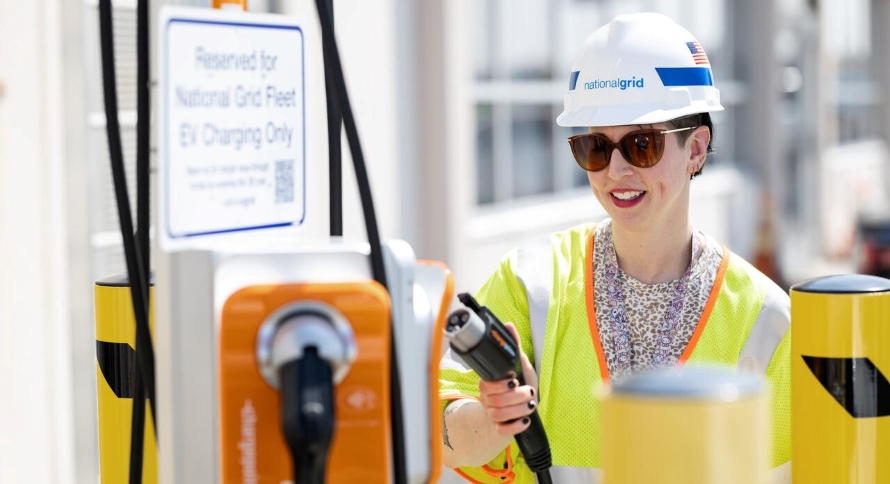Readying the Northeastern U.S. for Electric Trucks: National Grid to Build DOE Funded Roadmap
Categories:

WALTHAM, MA and BROOKLYN, NY – National Grid today is announcing the kickoff of a landmark study to support the electrification of commercial fleets, mapping out truck charging needs across nearly 3,000 miles of major highways in the U.S. Northeast. Funded by a $1.2 million grant awarded by the U.S. Department of Energy (DOE), the two-year effort to build a Northeast Freight Corridors Charging Plan will focus on highways with heavy trucking traffic, including I-95 and I-90, and areas with commercial activity, like the Port of New York and New Jersey.
The study led by National Grid will develop 20-year demand forecasts for more than 100 sites across New York, New Jersey, Pennsylvania, and all New England states. This analysis could guide investment and policy decisions, while providing a clear path for states, utilities, businesses, and local communities to plan and build a charging network that supports large-scale electrification of the largest emitting sector of the Northeast’s economy.

The Northeast Freight Corridors Charging Plan will expand upon National Grid’s first-in-the-nation Electric Highways Study released in 2022, which found that large highway fast-charging sites could require more power than a small town by 2045.
As more electric trucks enter roadways, grid and charging infrastructure must keep pace. Larger electric vehicles require frequent recharging on long haul routes, but charging options for electric trucks remain limited, with most charging stations only equipped to serve smaller passenger vehicles.
"Readying our grid infrastructure for electric trucks will require careful planning and close collaboration across state lines,” said Bart Franey, Vice President of Clean Energy Development - New York, National Grid. “This DOE grant award brings the right stakeholders into the same room to chart a clear course for electric truck charging across the Northeast. This roadmap will inform efforts by states, utilities, communities, and industry leaders to create a seamless truck charging network across the region.”
A Coordinated Effort to Ramp Up an East Coast Charging Network
National Grid is engaging with industry partners to drive transportation electrification in the Northeast and help communities keep pace with policy- and market-driven demand now and in the future. The company is leading this groundbreaking study effort in partnership with RMI, the Northeast States for Coordinated Air Use Management (NESCAUM), Clean Communities of Central New York, and DOE’s National Renewable Energy Laboratory (NREL).
National Grid will also closely coordinate with CALSTART, the recipient of a similar DOE grant, to map out truck charging needs south of National Grid’s study area. The two studies are set to cover a combined 3,700 miles of highways and freight corridors, including 1,300 miles of I-95 from Georgia all the way to the Canadian border – plotting out what could be one of the longest truck charging corridors in the country. When integrated together, this broader analysis will span 15 states, supporting more than 300 million tons of freight moving through ports on the East Coast each year, as well as several of the largest cities in the U.S.
John Boesel, president and CEO of CALSTART said, “The I-95 Corridor project, once completed, will put into practice the integration of zero-emission vehicles, infrastructure, and addressing climate-change issues that has been carried out in other areas of the country. The successful implementation of this project will put to rest the unfounded concerns of zero-emission opponents by demonstrating that this technology is both economically feasible and a benefit to all.”
David Sandbank, Vice President of Distributed Energy Resources New York State Energy Research and Development Authority (NYSERDA) said, “This study will help deepen the understanding of electrification needs and help New York State and the region strategically put more medium and heavy-duty electric trucks on the road. Growing the number of charging locations throughout key travel corridors will lower emissions and pollution while ensuring goods and services are delivered in a cleaner, more sustainable way.”
Paul Miller, Executive Director of NESCAUM, a regional association of air quality agencies in eight northeast states that will help engage state governments in the Northeast Freight Corridors Charging Plan said, “A rapid transition to zero-emission freight transport is urgently needed to slash greenhouse gas emissions and to improve air quality and public health in the communities along freight routes that have long borne inequitable impacts from diesel-powered trucking. This foundational study will help to expedite a charging network that can scale quickly and cost-effectively as more zero-emission trucks take to the road.”
About National Grid
National Grid (NYSE: NGG) is an electricity, natural gas, and clean energy delivery company serving more than 20 million people through our networks in New York and Massachusetts. National Grid is focused on building a smarter, stronger, cleaner energy future — transforming our networks with more reliable and resilient energy solutions to meet state climate goals and reduce greenhouse gas emissions.
Media Contacts
Related News
